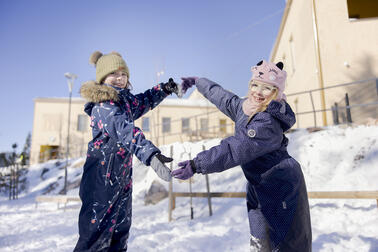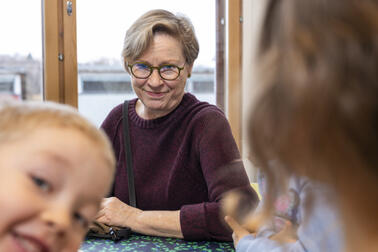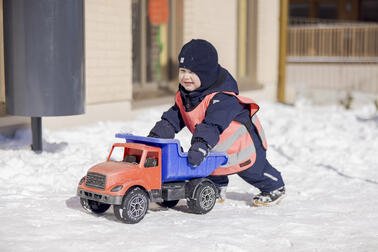
You would not believe that we are in one of the largest day-care centres in Helsinki. Kindergarten Vaapukka is located in Sinivuokonpolku, which is close to Itäkeskus and Marjaniemi. There are about 240 children in the kindergarten.
The facilities of the building, which are a couple of years old, are designed in such a way that there are facilities of many different types and sizes for groups. No disturbing noises are heard, as a great deal of attention has been paid to acoustics and the activities of the groups have been carefully planned.
The facilities of the pre-primary education aged children and the Puotila primary school's branch office are on the second floor of the building.
The calm atmosphere also draws the attention of Mayor Juhana Vartiainen and Deputy Mayor Johanna Laisaari, who are visiting Vaapukka.
Daycare centre manager Jarna Mäki says that the staff was consulted in the design of the building from the very beginning. The pedagogues told the architects what high-quality early childhood education requires from the building. A big advantage was to combine the school's facilities in the same building, as this resulted in a large number of versatile common areas, such as a large gymnasium, which can be used by all groups.
The staff gave praise to the fact that the premises can be adapted to the activity during the day.
Mäki and Antti Lehto-Raevuori, early childhood education district manager, will take you on a tour of the illuminated facilities. In the lobby, members of the Pilvenhattarat (Cloudlets) group bake apple pie under the guidance of early childhood education teacher Minna Saarenoksa. The bakers assure that the result will be delicious.
The gymnasium on the second floor currently hosts a pre-primary education group, whish is being soothed by the nanny Helena Raappana and early childhood education teacher Päivi Tierto.
Second-graders are attending an English lesson in the common classroom. Principal Aliisa Ranta shows how to split the room into two more compact rooms to the sliding door, if teachers want to teach a smaller group in a separate area.

Compliments from staff and guardians
“The City of Helsinki does not build premises that would not allow activities beneficial to children and the well-being of employees. We have succeeded, because people here are clearly enjoying themselves,” Laisaari says.
You can feel that there is a good atmosphere in Vaapukka, and this is also evidenced by the retention of the staff and the top results of the employee satisfaction survey.
The parents of the children are also giving positive feedback. Johanna Kallio, whose two children are attending daycare in Vaapukka and whose third child is attending the school there, also expresses her thanks.
“This house works like a charm, but the quality of daycare is not dependent on size. Vaapukka is clearly well managed,” she says.
According to Kallio, the advantages of Vaapukka include multiculturalism. The variety of languages is extensive, but the daycare centre manager tends not to count how many children speak a language other than Finnish as their mother tongue. Here, everyone is a member of Vaapukka.
However, second-graders are proud to showcase the door where they have assembled flags from different countries. They describe the backgrounds of the children in the group.

Small children have a small campus of their own
According to Laisaari, the campus thinking familiar from the student world is well implemented in Vaapukka. Vaapukka's “campus” consists of a playground, kindergarten and school, as well as yards and green areas.
“The functionality of the area is also visible in the fact that well-planned and unified recreational areas also have enough attendants in the evenings.
And this is how it goes in practice: Some of the children in daycare have visited the playground with their parents before going to the daycare centre. The area is familiar when they start going to the daycare centre. Cooperation with the playground will continue in the daycare centre.
Short distances also make it possible to share indoor and outdoor facilities, as well as common events between the playground, daycare centre and school. The adults are also familiar to everyone.
Laisaari thinks that this type of uniform yard design that is safe for children should be duplicated in the city in the future.
Since the preschool and the school are on the second floor of the same building, you can move there without undue pressure.
Everyday life for families is greatly facilitated by the fact that the first and second-grader's afternoon activities are organised in the familiar playground next to the daycare centre and school.
According to Principal Aliisa Ranta, the fact that professionals can work together to ensure a good start of school for each student in the transition phase is a great advantage.
“Cooperation between different actors is well implemented in Vaapukka. Families and education staff benefit greatly from the way how playground activities, kindergarten and school are intertwined,” Vartiainen says.

300 locations for early childhood education
Laisaari says that Helsinki's advantage in early childhood education is versatility. The total number of facilities is about 300, and it can accommodate both small and large units. Some pedagogues prefer small units while others prefer larger units.
The wishes of the guardians are also taken into consideration when applying for a place in a daycare centre for a child. In general, a place is searched close to home.
The city wants early childhood education to be of high quality, regardless of the location. Laisaari points out that since there is a shortage of early childhood education staff throughout the country, Helsinki must constantly take care of its retention and attractiveness. One factor in this is working facilities.
Lehto-Raevuori's experiences of large units are very positive. When a large building is planned smartly, it is as if there are many small kindergartens in one building, but also diverse common areas that would not be available in individual kindergartens.
“Early childhood education is the cornerstone of education and training. We must ensure that every child gets to experience a sense of belonging and that everyone feels that they will have the opportunity to pursue whatever they want in the future,” Lehto-Raevuori says.

Text and pictures: Kirsi Riipinen


